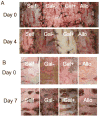Prolonged survival of GalT-KO swine skin on baboons
- PMID: 20522247
- PMCID: PMC2905853
- DOI: 10.1111/j.1399-3089.2010.00576.x
Prolonged survival of GalT-KO swine skin on baboons
Abstract
Background: Allogeneic skin is currently the best alternative to autologous skin as a temporary treatment for severe burns, but it has several drawbacks. As a potential alternative, we have evaluated GalT-KO swine skin, which lacks expression of the Gal epitope, to investigate the effect of eliminating this epitope on survival of pig-to-baboon skin grafts.
Methods: Two adult baboons that had fully recovered from previous T cell depletion received simultaneous skin grafts from: (i) GalT-KO swine, (ii) Gal-positive swine, (iii) a third-party baboon, and (iv) self (control skin). Recipients were treated with cyclosporin for 12 days and the survival, gross appearance, and histology of the grafts were compared.
Results: In both baboons, the GalT-KO skin survived longer than either the Gal-positive swine skin or the allogeneic skin. Early rejection of the Gal-positive skin appeared to be mediated by cytotoxic preformed anti-Gal IgM antibodies, while the rejection of GalT-KO skin appeared to result from cellular mechanisms.
Conclusions: GalT-KO skin may have potential clinical benefits as an alternative to allogeneic skin as a temporary treatment for severe skin injuries.
Figures



 = Gal-positive cell targets without DTT, solid gray line
= Gal-positive cell targets without DTT, solid gray line  = GalT-KO cell targets without DTT, dashed black line = Gal-positive cell targets with DTT).
= GalT-KO cell targets without DTT, dashed black line = Gal-positive cell targets with DTT).
Similar articles
-
Occurrence of specific humoral non-responsiveness to swine antigens following administration of GalT-KO bone marrow to baboons.Xenotransplantation. 2010 Jul-Aug;17(4):300-12. doi: 10.1111/j.1399-3089.2010.00600.x. Xenotransplantation. 2010. PMID: 20723202 Free PMC article.
-
Increased levels of anti-non-Gal IgG following pig-to-baboon bone marrow transplantation correlate with failure of engraftment.Xenotransplantation. 2013 Nov-Dec;20(6):458-68. doi: 10.1111/xen.12065. Epub 2013 Oct 29. Xenotransplantation. 2013. PMID: 24289469 Free PMC article.
-
Genetically modified porcine split-thickness skin grafts as an alternative to allograft for provision of temporary wound coverage: preliminary characterization.Burns. 2015 May;41(3):565-74. doi: 10.1016/j.burns.2014.09.003. Epub 2014 Oct 16. Burns. 2015. PMID: 25406888
-
Gal/non-Gal antigens in pig tissues and human non-Gal antibodies in the GalT-KO era.Xenotransplantation. 2011 Jul-Aug;18(4):215-28. doi: 10.1111/j.1399-3089.2011.00644.x. Xenotransplantation. 2011. PMID: 21848538 Review.
-
Immune responses to alpha1,3 galactosyltransferase knockout pigs.Curr Opin Organ Transplant. 2009 Apr;14(2):154-60. doi: 10.1097/MOT.0b013e328329250d. Curr Opin Organ Transplant. 2009. PMID: 19300259 Review.
Cited by
-
A Comparative Examination of the Clinical Outcome and Histological Appearance of Cryopreserved and Fresh Split-Thickness Skin Grafts.J Burn Care Res. 2017 Jan/Feb;38(1):e55-e61. doi: 10.1097/BCR.0000000000000431. J Burn Care Res. 2017. PMID: 27606556 Free PMC article.
-
Progress in pig-to-non-human primate transplantation models (1998-2013): a comprehensive review of the literature.Xenotransplantation. 2014 Sep-Oct;21(5):397-419. doi: 10.1111/xen.12127. Epub 2014 Sep 1. Xenotransplantation. 2014. PMID: 25176336 Free PMC article. Review.
-
Topical Delivery of Immunosuppression to Prolong Xenogeneic and Allogeneic Split-Thickness Skin Graft Survival.J Burn Care Res. 2018 Apr 20;39(3):363-373. doi: 10.1097/BCR.0000000000000597. J Burn Care Res. 2018. PMID: 28639977 Free PMC article.
-
Lack of cross-sensitization between α-1,3-galactosyltransferase knockout porcine and allogeneic skin grafts permits serial grafting.Transplantation. 2014 Jun 27;97(12):1209-15. doi: 10.1097/TP.0000000000000093. Transplantation. 2014. PMID: 24798308 Free PMC article.
-
Skin xenotransplantation: Historical review and clinical potential.Burns. 2018 Nov;44(7):1738-1749. doi: 10.1016/j.burns.2018.02.029. Epub 2018 Mar 27. Burns. 2018. PMID: 29602717 Free PMC article. Review.
References
-
- Orgill DP. Excision and skin grafting of thermal burns. N Engl J Med. 2009;360:893–901. - PubMed
-
- Nakazawa H, Nozaki M. Experience of immediate burn wound excision and grafting for patients with extensive burns. Nippon Geka Gakkai Zasshi. 2005;106:745–749. - PubMed
-
- Wang YB, Ogawa Y, Kakudo N, Kusumoto K. Survival and wound contraction of full-thickness skin grafts are associated with the degree of tissue edema of the graft bed in immediate excision and early wound excision and grafting in a rabbit model. J Burn Care Res. 2007;28:182–186. - PubMed
-
- Lari AR, Gang RK. Expansion technique for skin grafts (Meek technique) in the treatment of severely burned patients. Burns. 2001;27:61–66. - PubMed
Publication types
MeSH terms
Substances
Grants and funding
LinkOut - more resources
Full Text Sources
Other Literature Sources
Medical
Molecular Biology Databases
Research Materials

